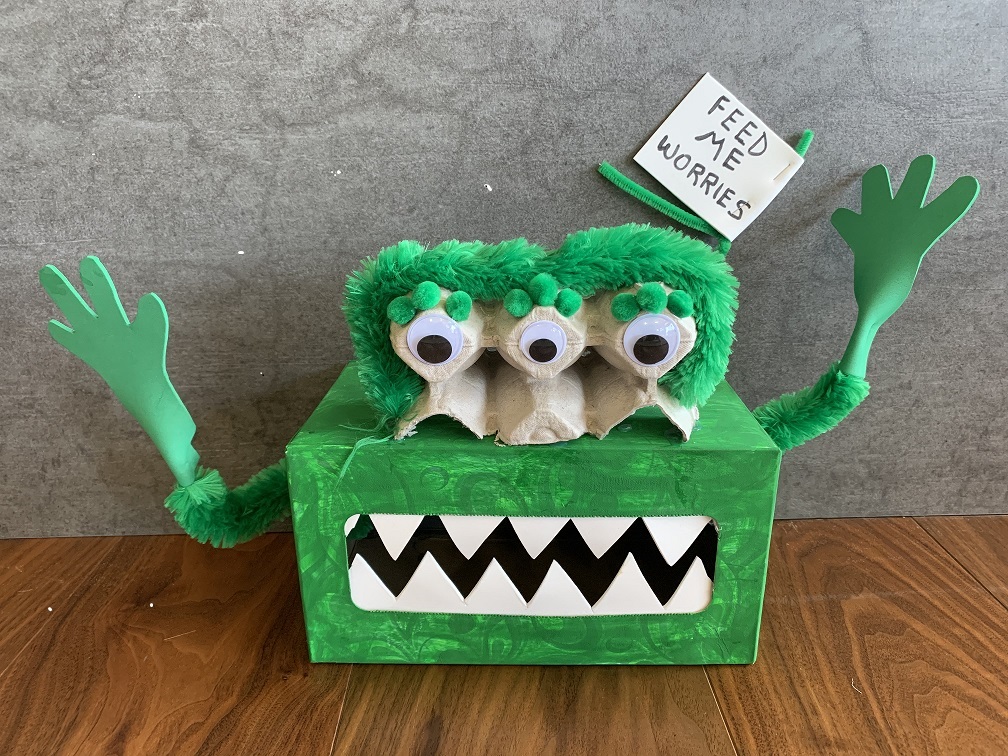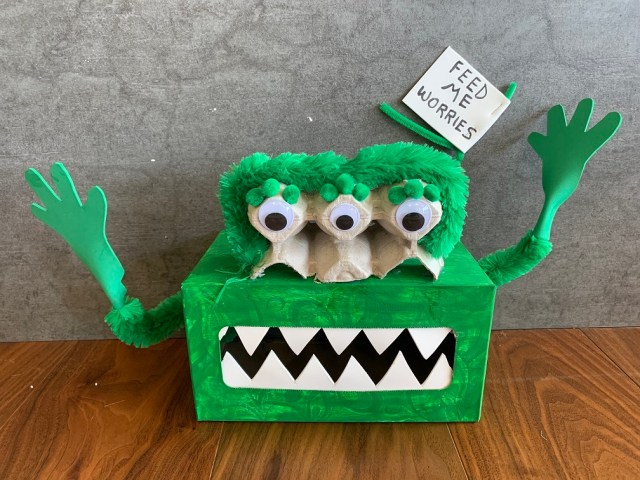
What if there was a DIY Worry Box that helped reduce your child’s worry, improved her sleep, and gave you a fun activity to do with her? What if the idea behind the craft was based on research-based strategies that successfully lowered anxiety? Would you be interested? Of course!
More than ever, we need help reducing our anxiety. Research shows that the mental health toll on children (and their parents) from the pandemic is growing. In other words, our children are showing ever more symptoms of anxiety, poor sleep, and feeling lonely and uncertain. With online school, we expect anxiety to only get worse. In addition, many parents are with their children 24/7 and are desperate for activities that will calm their kids. A DIY Worry Box offers a way to keep the worries in check, improve sleep, AND make a fun craft.
As a child psychologist who specialized in work with anxious children, I often had kids write down their worries and put the paper in a “Worry Box.” The relief for most children was immediate because they could name their worry, write it down, and then put the paper into a closed container. The worry was contained and felt more manageable. Initially, I used a simple box with a lid and named it the Worry Box. With the writing of my children’s book on worry, the Worry Box was enhanced to be a child-created monster that can be as unique, crazy, or silly as the child wants.
The simple-sounding idea of putting a written worry in a Worry Box (containment) comes from Cognitive Behavioral Therapy (CBT), which is widely regarded as the most effective way to manage anxiety in both children and adults. Before learning to make the Worry Box, let’s learn more about containment and why it is so effective.
Containment
Containment is one of the basic principles of CBT. An analogy can help to understand it better. Imagine a yellow dandelion flower. The immature seeds are contained within the yellow flower and are not reproducing. But when the flower changes to a white fluffy seedhead, the mature seeds scatter in the wind. The seeds are no longer contained and they spread everywhere! Soon there are hundreds of new dandelions. If only you could contain all those seeds before they spread.
Now imagine that the mature dandelion seeds are worries. With the slightest provocation and without a container, worries can scatter everywhere. The worries can spread to bother a child (or an adult) anywhere and anytime. If you were just able to hold the worries in a container, they would feel manageable. You know you CANNOT contain mature dandelion seeds, but you CAN contain worries!
How to Make a Worry Box
Children will feel more in control (and have fun) if they are the ones to make their own container to hold their worries. You can make a worry box out of any kind of container. This Worry Box is designed to look similar to the big green Worry Monster in the author’s book. The difference between a Worry Box and Worry Monster is that the Worry Box holds your worries for you (a good thing) and the Worry Monster takes the worries in so he can grow bigger and scare you more (not so good).
For this Worry Box, supplies include a tissue box, chenille pipe cleaners, wiggle eyes, glue, an egg carton, acrylic paint, markers, stapler, puffballs, and foam sheets.
1. Paint the tissue box with acrylic.
2. Cut the foam to make teeth and hands.
3. Stick pipe cleaners into the box sides for arms and then staple the hands to the arms.
4. Cut and glue an egg carton for the top of head and glue on eyes.
5. Stick a pipe cleaner in for the sign and write “FEED ME WORRIES!”.
That’s it! A tutorial on how to make the box will be available on my website.
Your monster could be any color and have anything added to it. There are endless ideas on the internet. Let this monster be your child’s creation. The important concept is to have a mouth or a slot where your child can insert a paper with a written or drawn worry.
How to Use a Worry Monster Box
The Worry Box is ideal for preschoolers through teens. After the box is made, show your child how to use it. Tell her that when a worry pops up, she can write or draw the worry to put into the monster’s mouth. If necessary, you can write the worry for her, but you shouldn’t get into a big discussion about the worry at that time. The main ideas are that the child is learning to contain her worry with very little adult help and the worry is being released from the child into a container. Tell your child that any number of worries, big or small, can be put in the monster’s mouth.
Ideally don’t peek at the worries, instead make it a safe place for your child. Then set up a Worry Time (another form of containment in time) each day to discuss the worries.
To help with sleep, have your child write down her worries just before bedtime and then put them in the Worry Box to be safely held. She can also put the Worry Box under her bed so she can write down worries that might bother her in the middle of the night. Children often have great success with this.
Of course, you want to help your child with his or her worry and sleep problems and you want to have fun with your kids. So get out your crafts and get to work!
Sally Baird, PhD is a retired child psychologist and co-author of a new book titled Shrinking the Worry Monster, A Kids’ Guide for Saying Goodbye to Worries. See her website at www.drsallyb.com. If your child has worries about COVID-19, you may want to read Dr. Sally’s blog on helping kids who worry about the pandemic, school, illness, and so much more!











